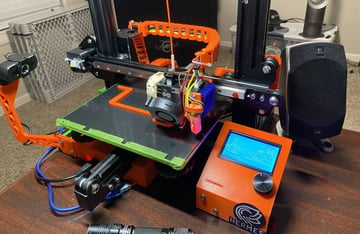Easy Does It

The Ender 3 is regarded as one of the best budget 3D printers made for hobbyists and people who want to learn more about 3D printing through trial and error. Part of the reason it’s so popular is that the Ender 3 is open source and doesn’t use any proprietary firmware or hardware.
The Ender 3 isn’t without its problems, though, and one way to fix problems or improve the printer is through installing upgrades, both physical (hardware) and digital (firmware). There are many upgrades available for the Ender 3, both to buy and to 3D print, which can improve printing quality and functionality.
In this article, we’ll be taking a look at a popular upgrade to the Ender 3 that adds stability to the X-axis gantry through the use of another Z-rod. The following sections will inform you about the specific upgrade and guide you step-by-step through the installation process. Let’s jump in!
Dual Wielding
The upgrade we’ll be presenting fixes one of the most frustrating annoyances for printing on the Ender 3: X-axis stability. The Ender 3 is an excellent printer, but it only has one Z-rod that supports the X-axis gantry. (The gantry is the apparatus that holds the hot end carriage above the print bed.)
THE PROBLEM
On a stock Ender 3, the X-axis gantry can sometimes lean and tilt because of how much weight it puts on the one Z-rod. This can compromise print quality, including bed leveling issues, as the hot end can be at a different height along the X-gantry if the gantry is tilted or wobbles. This wobbling can also lead to other issues, such as ringing in a print.
THE SOLUTION
Some people tighten the X-gantry screws when they experience a tilted or wobbly gantry. However, this is more of a temporary fix for a larger issue, whereas installing an additional Z-rod is a stronger and more permanent solution. With this upgrade, you’ll be adding an additional Z-rod on the other side of the gantry to offer more stability and ensure a level hot end carriage.
THE CAVEAT
One note is that for this upgrade, you’ll have to find a new spot to put your power supply unit (PSU), which is on the right side of your printer (behind your LCD screen). Luckily, you can reposition your PSU by shifting it slightly to the right using a 3D printable PSU mount. This will keep the power supply unit out of the way of the Z-axis as well as your desk or table space.
What You'll Need

For this upgrade, you’ll need some tools that should’ve come with your printer as well as some parts that’ll need to be purchased. We’ve chosen to use TH3D’s Ender 3 Dual Z Upgrade Kit, which is well documented and reasonably priced (around $70). If you’d like a cheaper option, you can also check out a non-brand option. Either way, you’ll be getting an array of different parts.
As we mentioned, you’ll need to move your PSU. To reattach it to your printer rather than just having it lying next to it, you can 3D print one of the models TH3D has listed on their website. As a bonus, moving your PSU to a more inconspicuous location by mounting it will make your printer look more organized.
For this upgrade, make sure you have the following materials (all should be included in the TH3D kit or whichever kit you choose):
- 4x M4 screws with T-nuts for bearing blocks
- 2x all-metal Z bearing blocks for Z-rods with bearings preinstalled
- 2x M3 screws with T-nuts & washers
- 3x M5 spacers
- 3x M5 screws
- 1x ACM tensioner bracket with idler preinstalled
- 2x M8 Pulleys
- 1x GT2 belt
- 1x Z-rod
Also, make sure you have all of the following tools:
- A double-sided wrench
- An assortment of Allen keys (1.5, 2, 2.5, 3, 4 mm)
- A small grub screw key (extra small Allen key)
Once you’ve got all your equipment, it’s time to begin!


